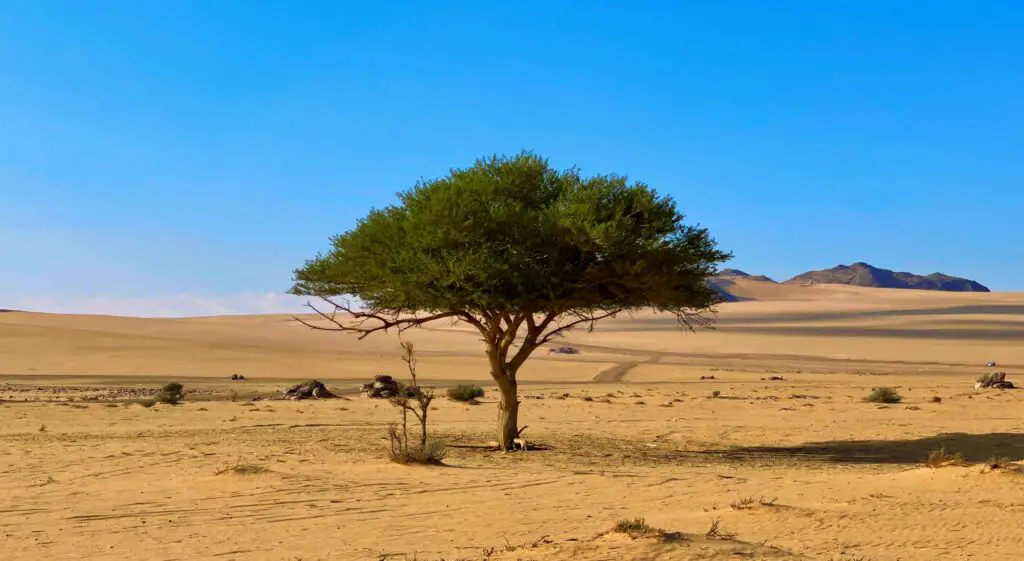Desertification is a huge environmental problem that, if we ignore it, could hurt the lives and incomes of millions of people. Simply put, desertification occurs when already dry, semi-dry, or slightly moister land keeps losing its ability to grow crops or support animals. Because these areas have little water to start with, they are especially hit hard by climate change and careless farming or grazing. By learning what desertification really is, we stand a better chance of protecting both communities and nature from its wide-ranging damage.
Definitions and Scope
Desertification is the slow slide of once-healthy land toward near-useless dirt that cannot feed plants or animals. While changing weather patterns start the process, poorly managed plowing, overgrazing, and cutting too many trees make matters much worse. Because of this mix, the problem spreads even where a full desert does not replace the soil.
- It hits regions called drylands-arid, semiarid, and dry subhumid zones.
- It shrinks soil, water, and plant health instead of simply pushing a desert forward.
- Over time, such loss weakens local economies, raises health risks, and can even cause conflicts.

Key Challenges in Measuring Desertification
Lack of a Unified Baseline
Measuring desertification is tricky because no single starting point is used worldwide. Different teams define problems, grade severity, and choose tools in their own way, which muddies any attempt to share findings fairly.
- Varying Definitions and Methods: From local folklore to laboratory tests, what counts as damaged soil differs community to community.
- Multiple Assessment Methods: Some researchers trust expert opinions, others dig into old photos or rely on satellite scans. Each approach shines light but has blind spots.
- Limited Long-term Analyses: Quick checks over a season or two often fail to catch big patterns, like droughts that return every few years.
- Need for Robust Indicators: A set of agreed yardsticks, like plant cover and soil richness, would let nations track damage in the same way.
Role of Climate Variability
Weather is never stable, and dry zones swing between wet and dry decades. When a fierce drought strips away green cover, it is hard to tell if nature, farmers, or both caused the loss.
- Interannual Rainfall Variations: One bad season may be mistaken for permanent harm, leading communities to abandon land that could recover.
- Complex Interactions: Reduced moisture can burn plants, and fewer plants can alter local breezes and temperatures, locking neighborhoods in a downward loop.
The Importance of Data Collection and Monitoring
Good data is the backbone of smart policy, and modern tools mix satellites with on-the-ground visits to tell a fuller story.
Remote Sensing and Ground-based Observations
High-flying cameras spot even tiny loss of green pixels, while local farmers double-check what the numbers really mean and why the changes occurred.
Accessibility: Thanks to new technology, satellites are cheaper to run today, yet steady funding is still needed if we want images every day and not just every month.
Consistency: Watching the same place year after year lets scientists spot real changes in climate or land use, instead of mistaking a bad season for a longer problem.
Socioeconomic Data at Local Levels
People in dryland areas still rely on crops and livestock, so knowing their incomes, health, and where families move helps explain how desertification hurts lives.
Linking Ecosystems to Livelihoods: Records of household budgets, clinic visits, and migration show exactly how shrinking soil and water affect everyday well-being.
Targeting Local Solutions: Data collected at village or county level tells planners where to send seeds, money, or training so resources fix problems instead of being wasted.
Interactions with Other Key Factors
Biodiversity
A mix of plants, bugs, and animals keeps soil rich and pollinates crops, yet clearing land or letting herds graze too hard can wipe out that variety. When biodiversity drops, the ground loses one more layer of defense against spreading desert.
Climate Change
Desertification and climate warming stir each other in a dangerous loop. Drying soils and vanished plants trap less carbon, and that missing sink makes the air even hotter for everyone.
Carbon Release: When earth turns to sand, the stored carbon can escape all at once, adding a big, instant jolt to global levels.
Temperature and Hydrology Shifts: Warmer days and erratic rain speed up erosion, drain rivers, and turn once-usable farms into dust.
Human Well-being
When farmland stops producing as it should, nearby people feel the pinch right away:
Economic. Fewer grains and sick animals lead to empty kitchens and quickly rising prices.
Social and Health. Weak diets, dried-up drinking wells, and forced road trips to find work become the new normal in scarred land.
Towards More Accurate Assessments
Overcoming Uncertainties and Data Gaps
Better blends of lab science and daily notes from farmers can shrink the gaps and headaches caused by missing data.
Community Engagement. Locals who help gather and double-check numbers often spot trends that outsiders miss.
Broader Metrics. Along with yields, watchers should track culture, social ties, and the quiet hum of nature, not just the harvest.
Integrated Policy and Community Action
Desertification pushes back harder when it is seen as only an earth problem. Plans for crops, cash, and citizens must pull together too.
Coordinated Efforts. Chasing joins between farm rules, water budgets, and welfare schemes makes every dollar and hour work smarter.
Empowerment. Tools, money, and hands-on training let villages craft solutions that stick, even when the climate throws a tantrum.
Conclusion
To really grasp what desertification means, we first need clear data, regular checks, and an honest look at how climate change and wildlife loss weave together. If we improve our measurements and shape policies that fit the daily lives of local people, we can slow new damage and boost the strength of at-risk communities. When scientists share new tools and neighbors care for their land, we can keep dry areas working well and spare tomorrow*s world from the heavy price of ignored soil.
